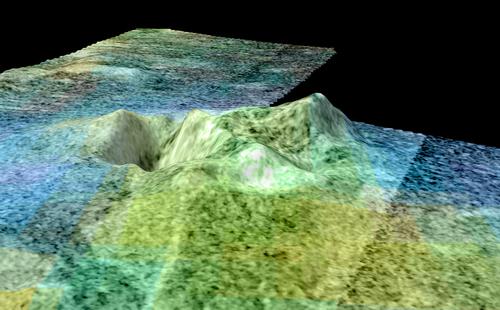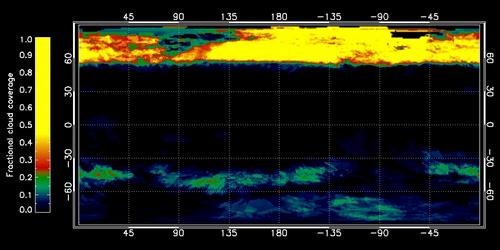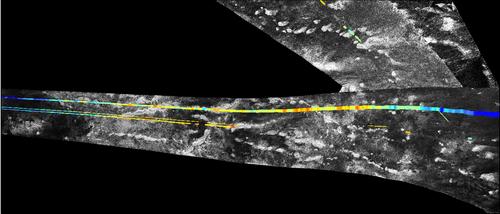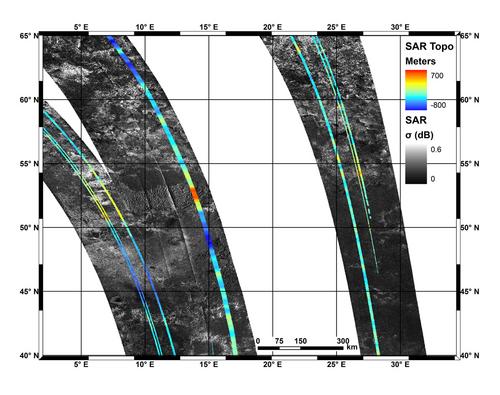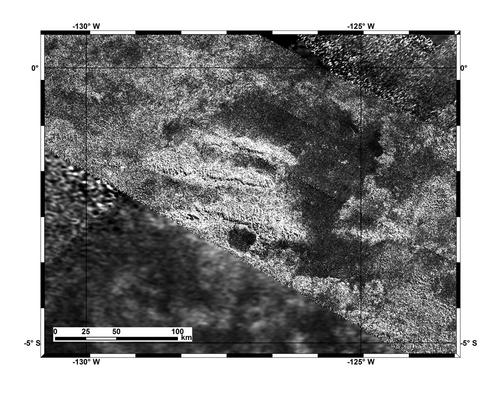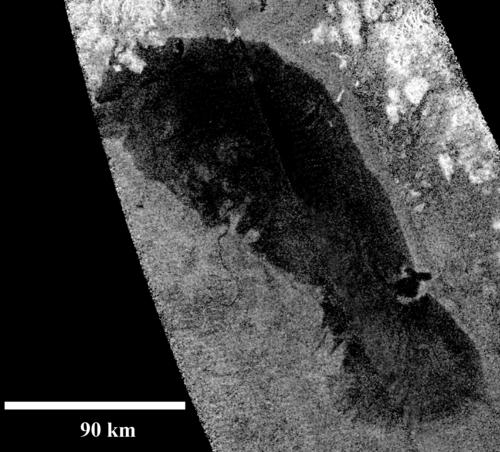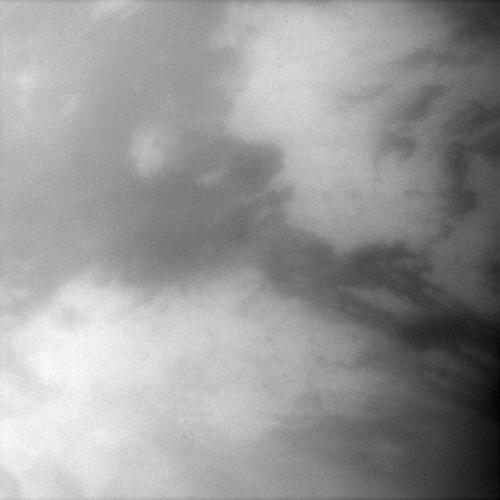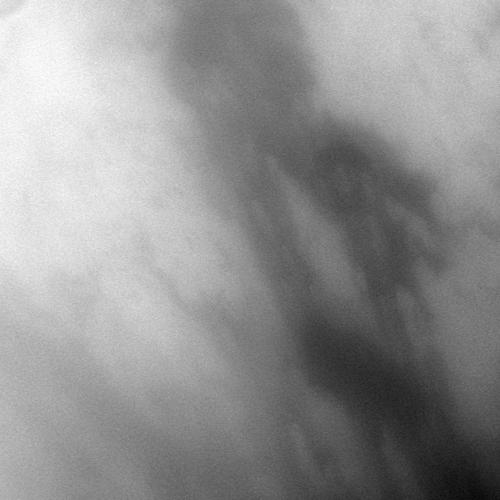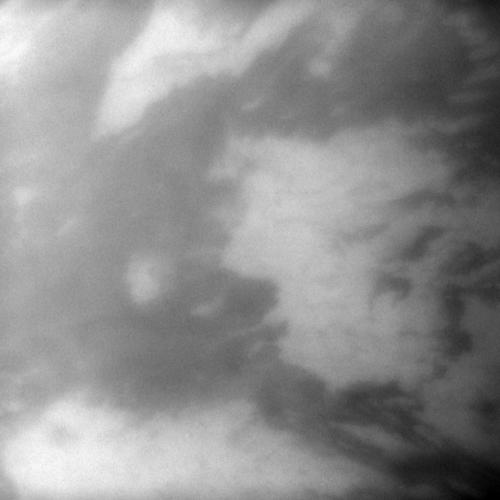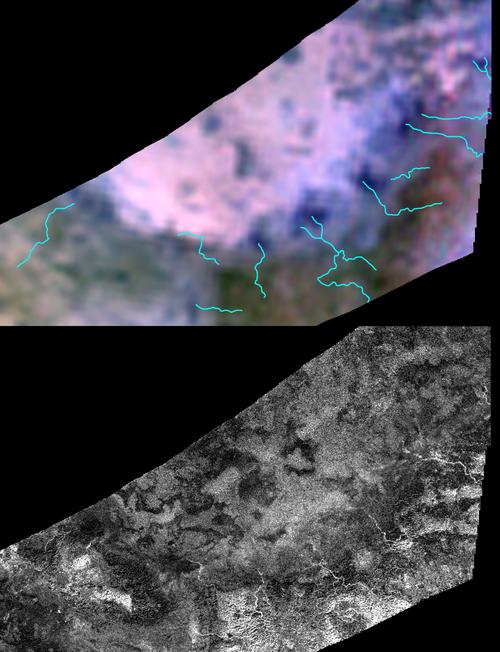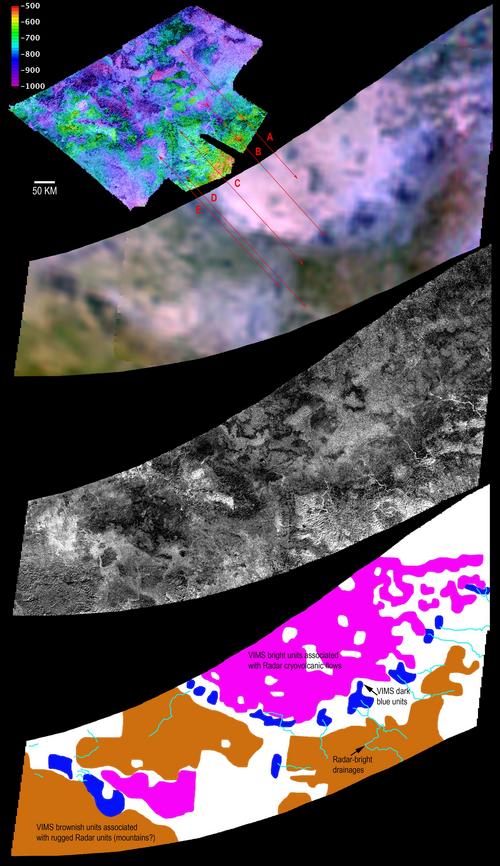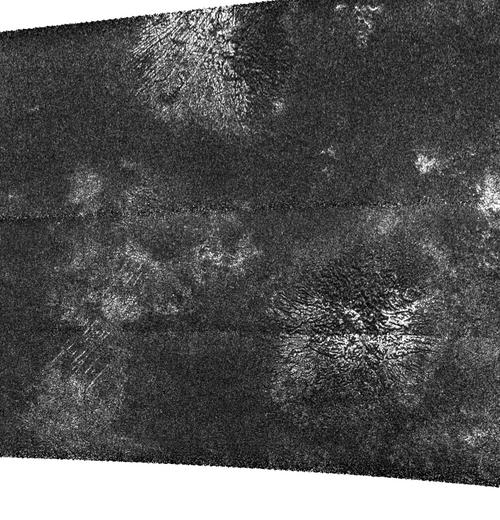Titan Images 2010
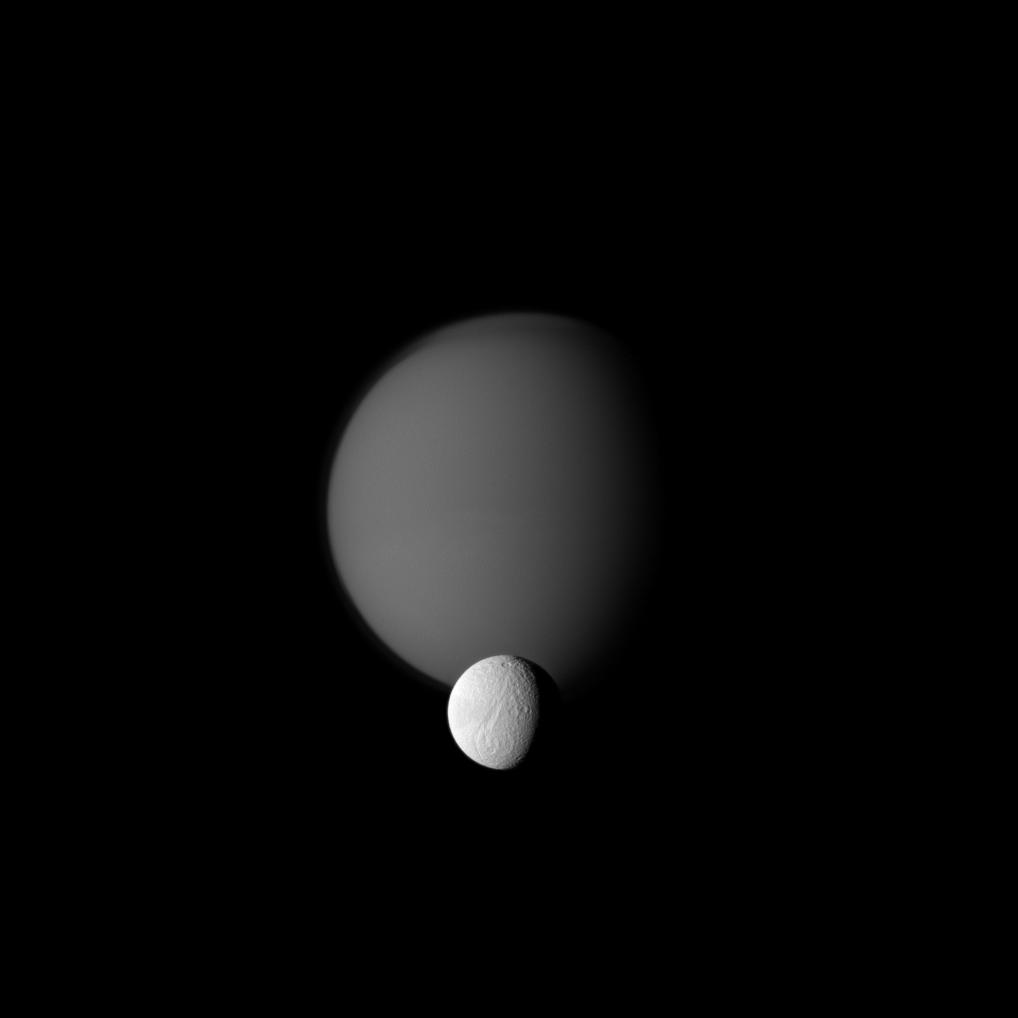 |
This image shows the icy moon Tethys in the foreground
and Saturn's largest moon, Titan in the background. One can notice
in this orbital configuration the bright, cratered surface of Tethys
as well as the topographic fracture
Ithaca Chasma running approximately north-south for more than 1,000
kilometers or 620 miles. Image Credit: NASA/JPL/Space Science Institute |
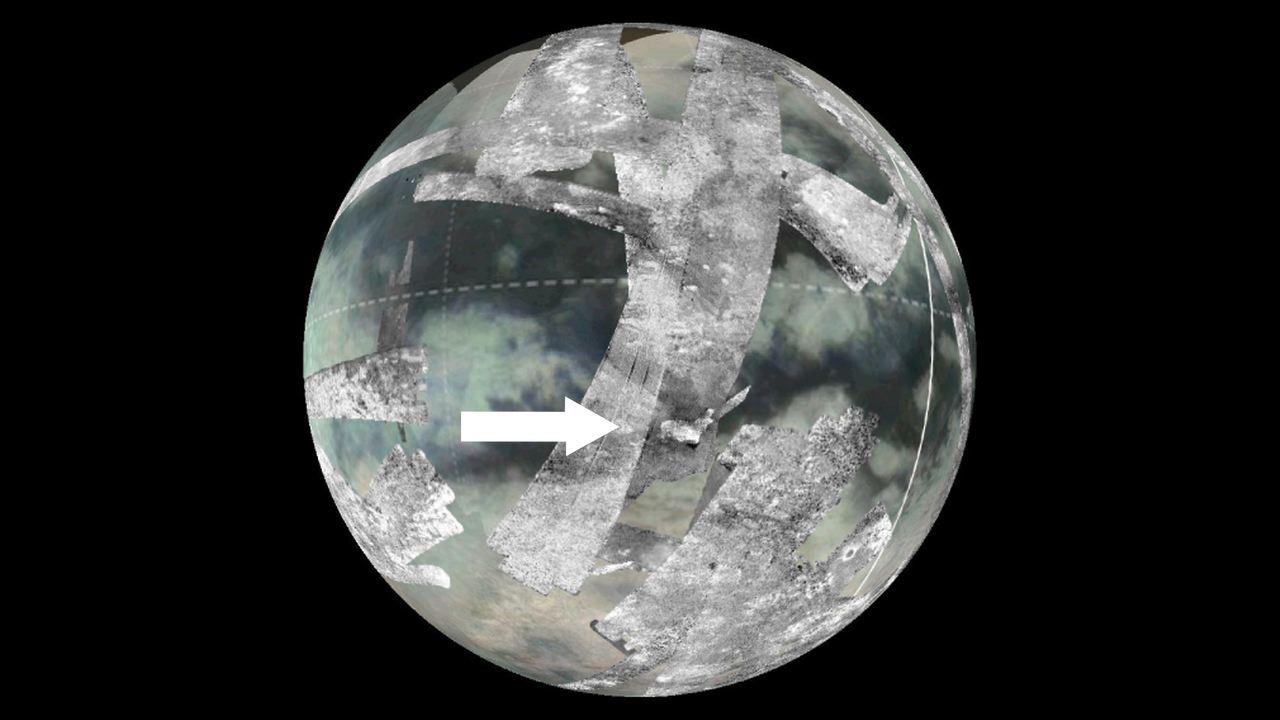 |
The images above reveal Sotra Facula, an optically
bright area of Titan believed to correspond to a cryovolcanic feature.
The view
of the globe of Titan which incorporates infrared or near-infrared
data as well as radar data shows the location of the bright Sotra Facula
in the optical H of Fensal/Aztlan. Sotra Facula is indicated by the
white arrow. Multiple radar swaths acquired by the radar mapper of
the Cassini probe are incorporated into the map of the globe. The radar
data sweep the area of Sotra Facula. The infrared or near-infrared
data obtained by the Visual and Infrared Mapping Spectrometer (VIMS)
cover the rest of the globe.
Sotra Facula is located around 15 degrees south latitude, 40 degrees
west longitude. The irregular topography and the optical appearance
of Sotra Facula suggest that it
may be
a cryovolcano
or an ice volcano. Image Credit (top view): NASA/JPL-Caltech/University of Arizona |
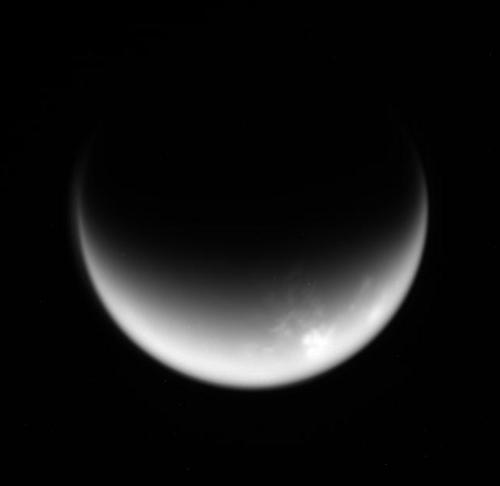 |
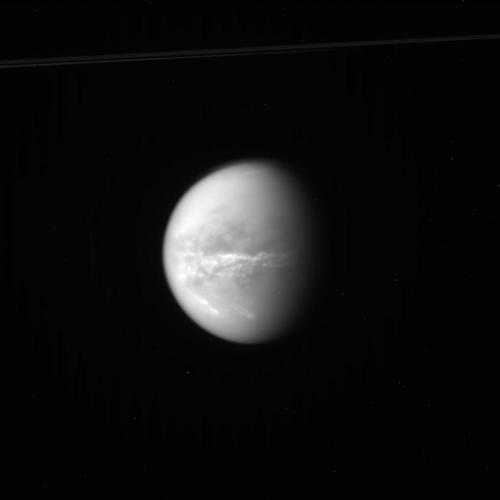 |
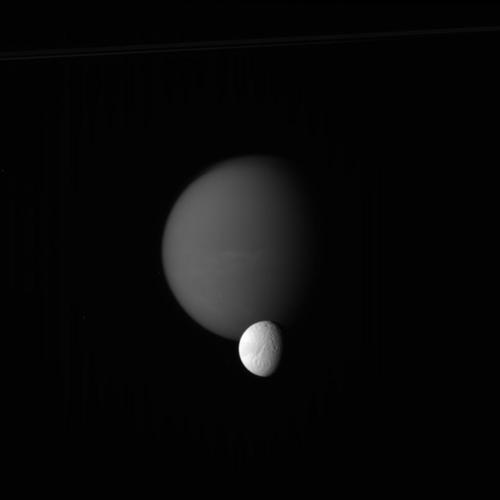 |
The three views above were obtained by the Cassini spacecraft
between October 14, 2010 and October 18, 2010. The top view which corresponds
to a raw image of Saturn's largest moon Titan was captured on October
14, 2010. The camera was pointing toward the Opaque Moon at about 207,643
kilometers (129,023 miles) away. The shot has not been validated or calibrated.
One can notice a large amount of cloud formations scattered, in the lower
part, in the illuminated portion of the disk. Image Credit: NASA/JPL/Space Science Institute |
This graphic based on data obtained by the Visual and
Infrared Mapping Spectrometer of the Cassini spacecraft reveals the
distribution and the percentage of cloud coverage on the globe of Saturn's
largest moon Titan. Latitudes and longitudes are represented along
the margins of the map and different colors are used to indicate the
percentage
of cloud coverage. The color scale on the left of the graphic links
the fractional cloud coverage to particular colors. The yellow represents
the highest cloud coverage. The maximum is associated with a complete
cloud coverage. The black color is on the other extreme of the
color scale, representing the minimum cloud coverage or no cloud coverage.
The graphic is the outcome of a survey ranging from July 2004 to April
2010. Image Credit: NASA/JPL/University
of Arizona/University of Nantes/University of Paris Diderot |
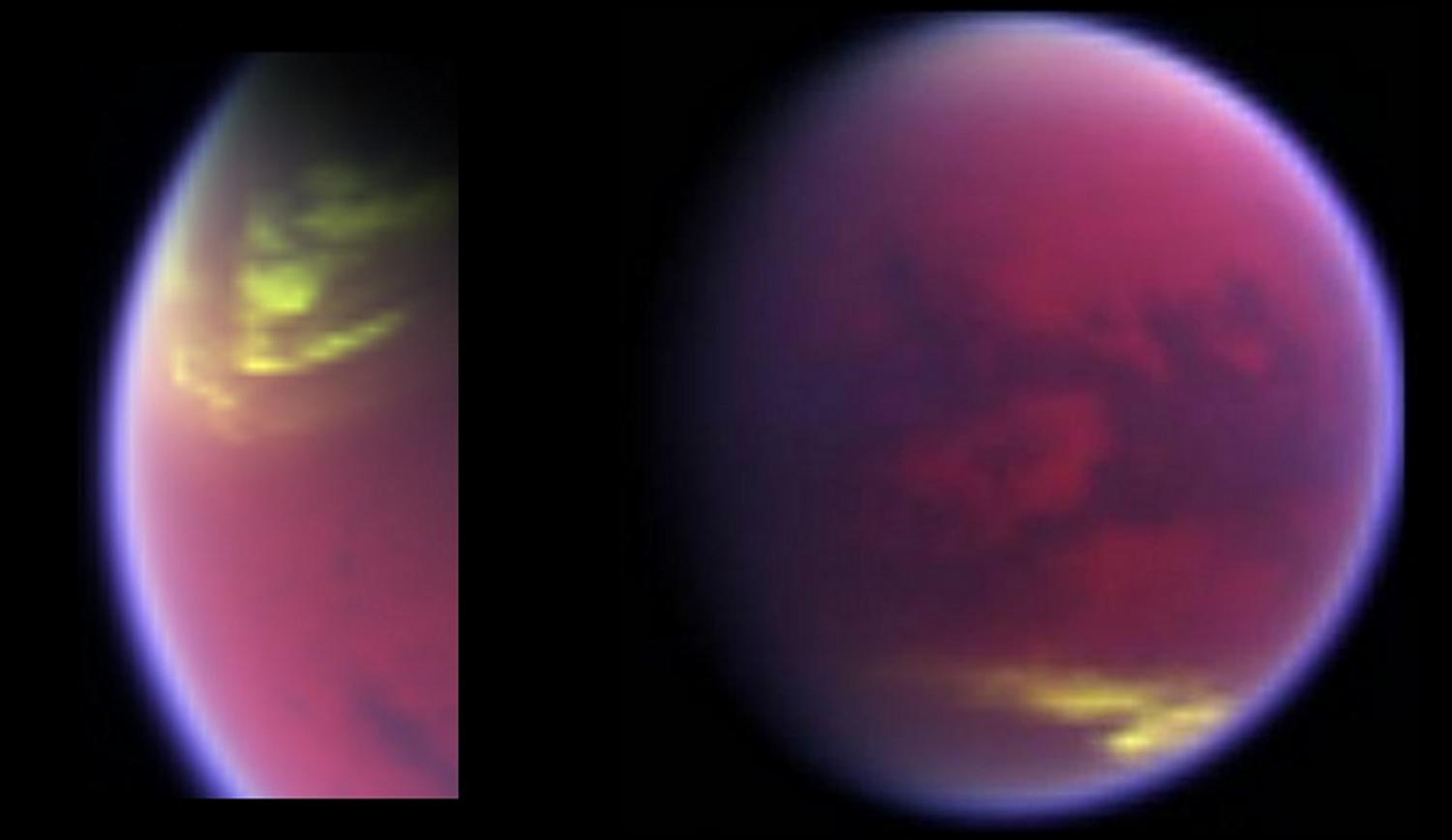 |
This mosaic of false-color images of Titan's globe reveals
changes in cloud coverage over the north polar region and developments
of cloud formations at mid-latitudes in the southern hemisphere of Saturn's
largest moon. Image Credit: NASA/JPL/University of Arizona/University of Nantes/University of Paris Diderot |
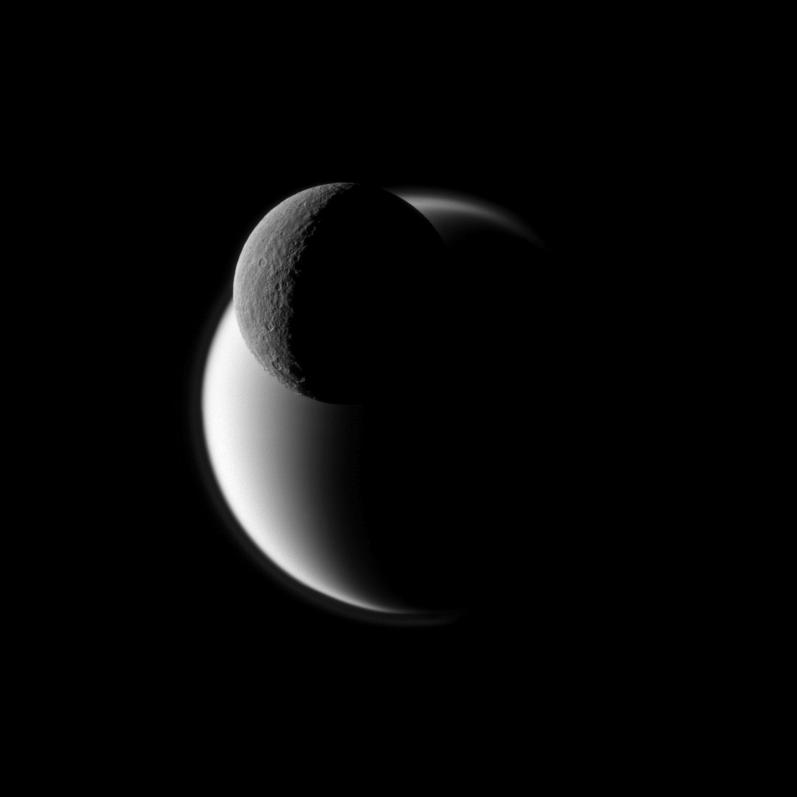 |
The two largest moons of Saturn, Titan and Rhea, can be
observed in this view showing the icy moon Rhea passing in front of the
Opaque Moon Titan. Rhea orbits closer to Saturn at a mean distance of
about 527,108 km (328,000 miles). Rhea is largely smaller than Titan
with a
diameter of about 1,528 km (949 miles). Image Credit: NASA/JPL/Space Science Institute |
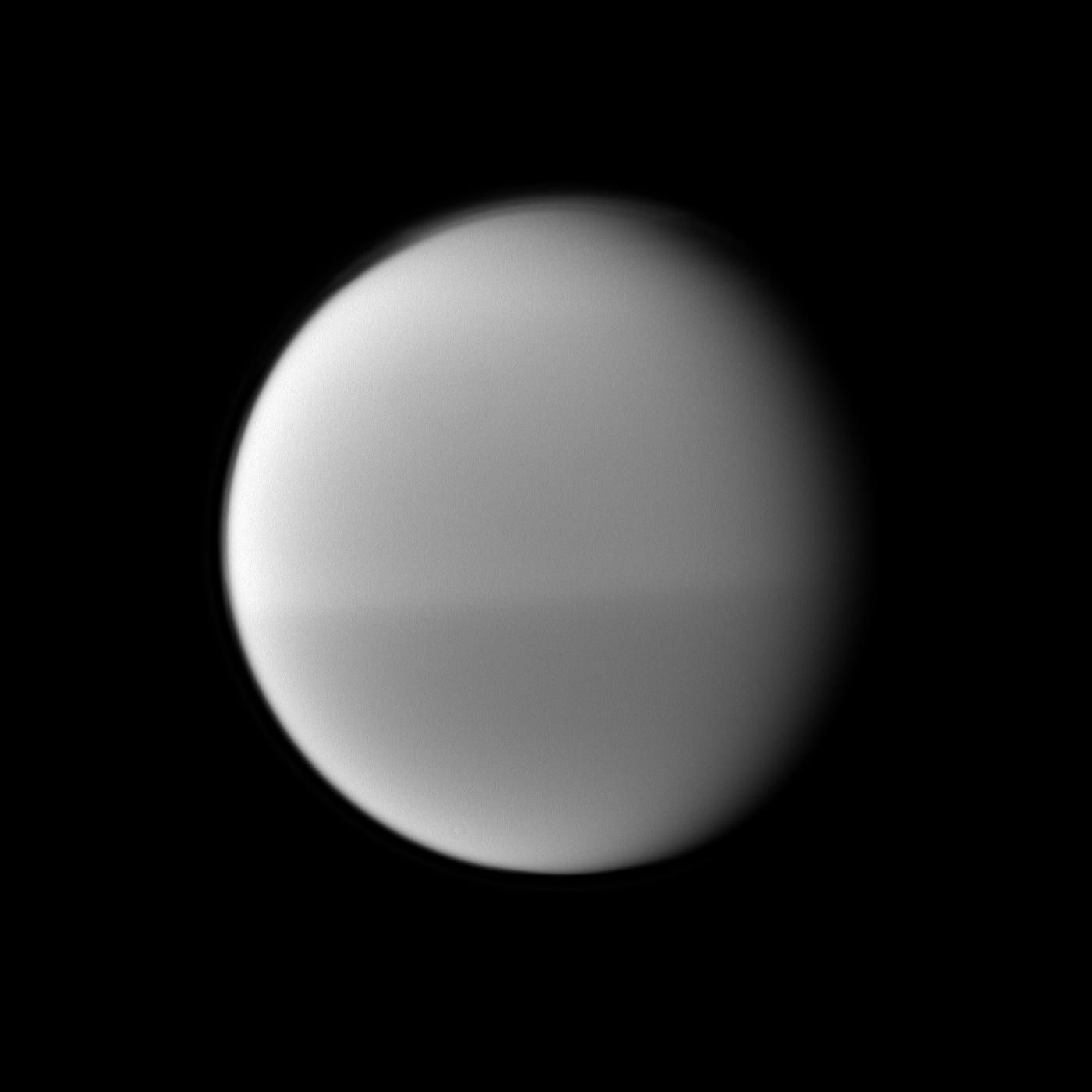 |
This near-infrared view of Titan's disk unveils the hemispheric
dichotomy related to seasonal factors. One can notice that the southern
half of the globe appears darker than the northern half. The southern
hemisphere is currently in the autumn season while the northern hemisphere
is in the spring season. Moreover, one can observe the north polar hood
and the detached haze layer in the upper atmosphere of Saturn's largest
moon. Image Credit: NASA/JPL/Space Science Institute |
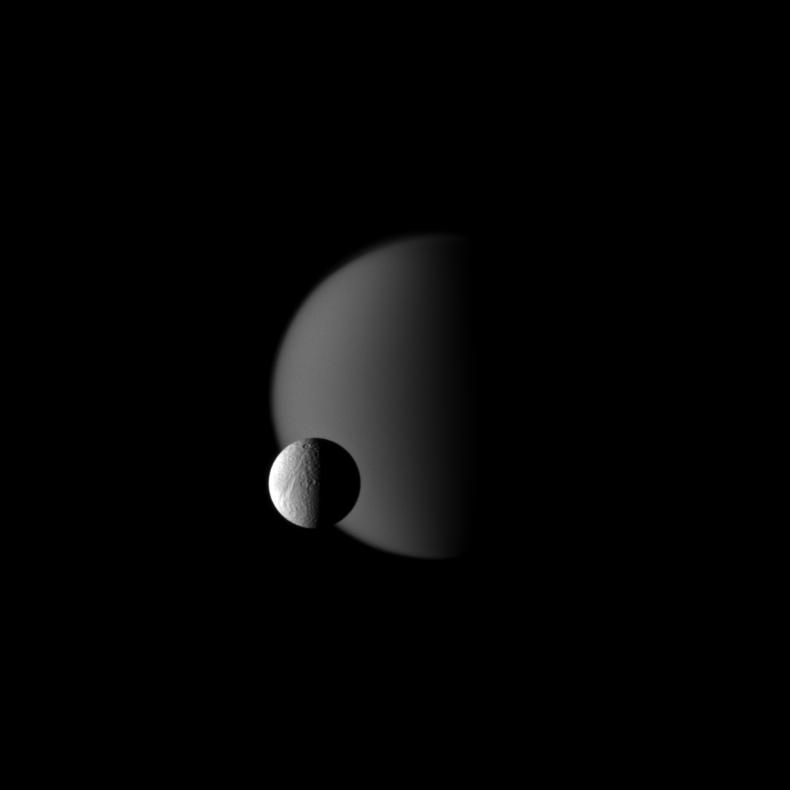 |
This visible light view reveals Tethys moving in front
of Saturn's largest moon Titan. One can clearly see the contrast between
the icy moon Tethys or Saturn III and the hazy and opaque moon Titan.
The terrain on Tethys has a particularly high albedo due to the presence
of large
amounts
of water ice. The most remarkable features of Tethys are the large crater
Odysseus and the giant valley or fracture known as Ithaca Chasma. Ithaca
Chasma likely results from extensional phenomena in the crust. The
giant impact that created Odysseus may have engendered a shockwave fracturing
the crust and generating the rift of Ithaca Chasma. Image Credit: NASA/JPL/Space Science Institute |
This mosaic of radar images reveals topographic data and
mountain chains near Adiri, an equatorial region of Saturn's largest
moon Titan. The composite view focuses on a region around 10 degrees
south latitude and 145 degrees east longitude. Image Credit: NASA/JPL-Caltech |
This mosaic of radar images obtained with the radar instrument
of the Cassini spacecraft reveals topographic data and mountains in the
northern hemisphere of Titan. The area appears in the north of the Aaru
region. The color strips unveil the elevation levels. The red and orange
colors unveil the highest land while the purple colors show the lowest
terrain. Image Credit: NASA/JPL-Caltech |
This radar mosaic reveals mountain chains on the northwest
border of the bright Xanadu on Titan. Three dark, parallel lines or ridges
can be seen in a bright, rugged terrain. A dark, circular feature in
that area may correspond to an ancient impact crater or it may represent
a cryovolcanic caldera. One can wonder whether there is a close relationship
between the formation of the dark, circular feature and the formation
of the parallel mountain chains in that bright area. Image Credit: NASA/JPL-Caltech |
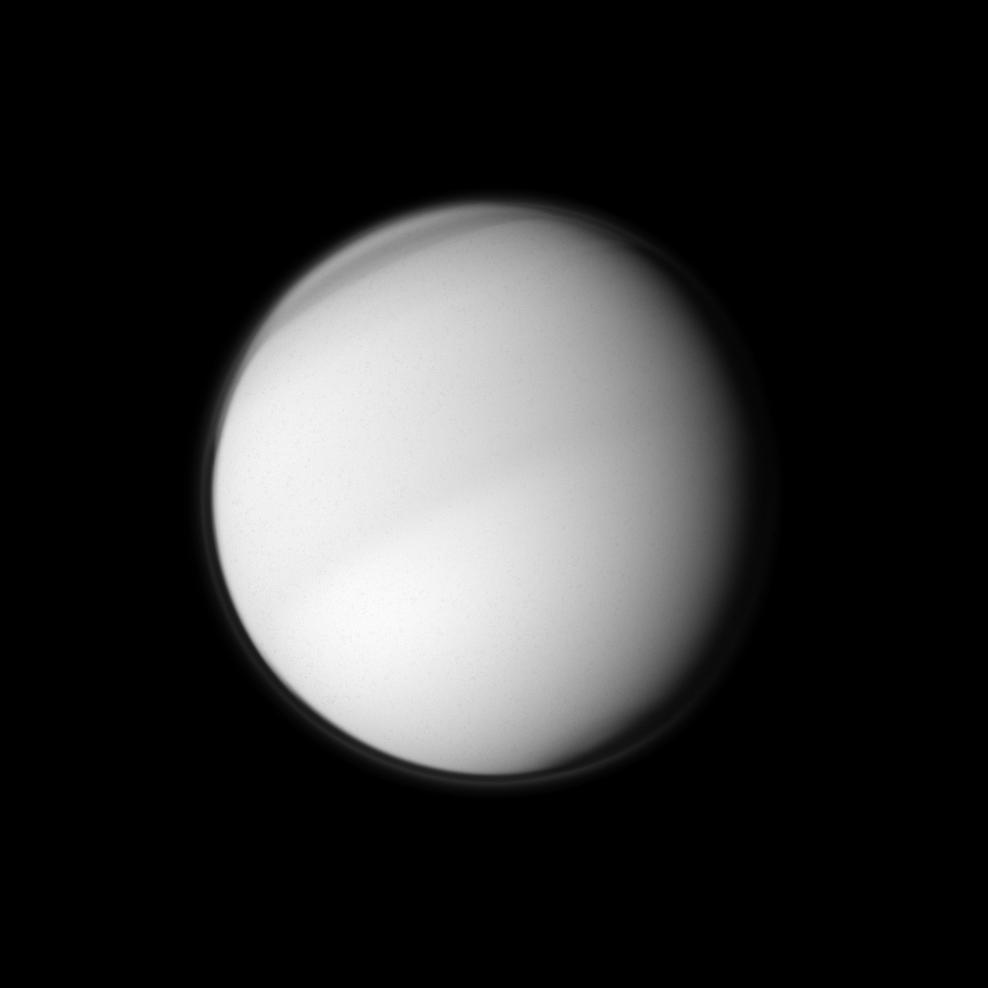 |
This view of Saturn's largest moon, Titan, reveals
the seasonal atmospheric banding. One can observe a dark atmospheric
band
in the north polar region as well as a linear atmospheric contrast
near the equator, marking a seasonal dichotomy between the northern
and southern hemispheres. Image Credit: NASA/JPL/Space Science Institute |
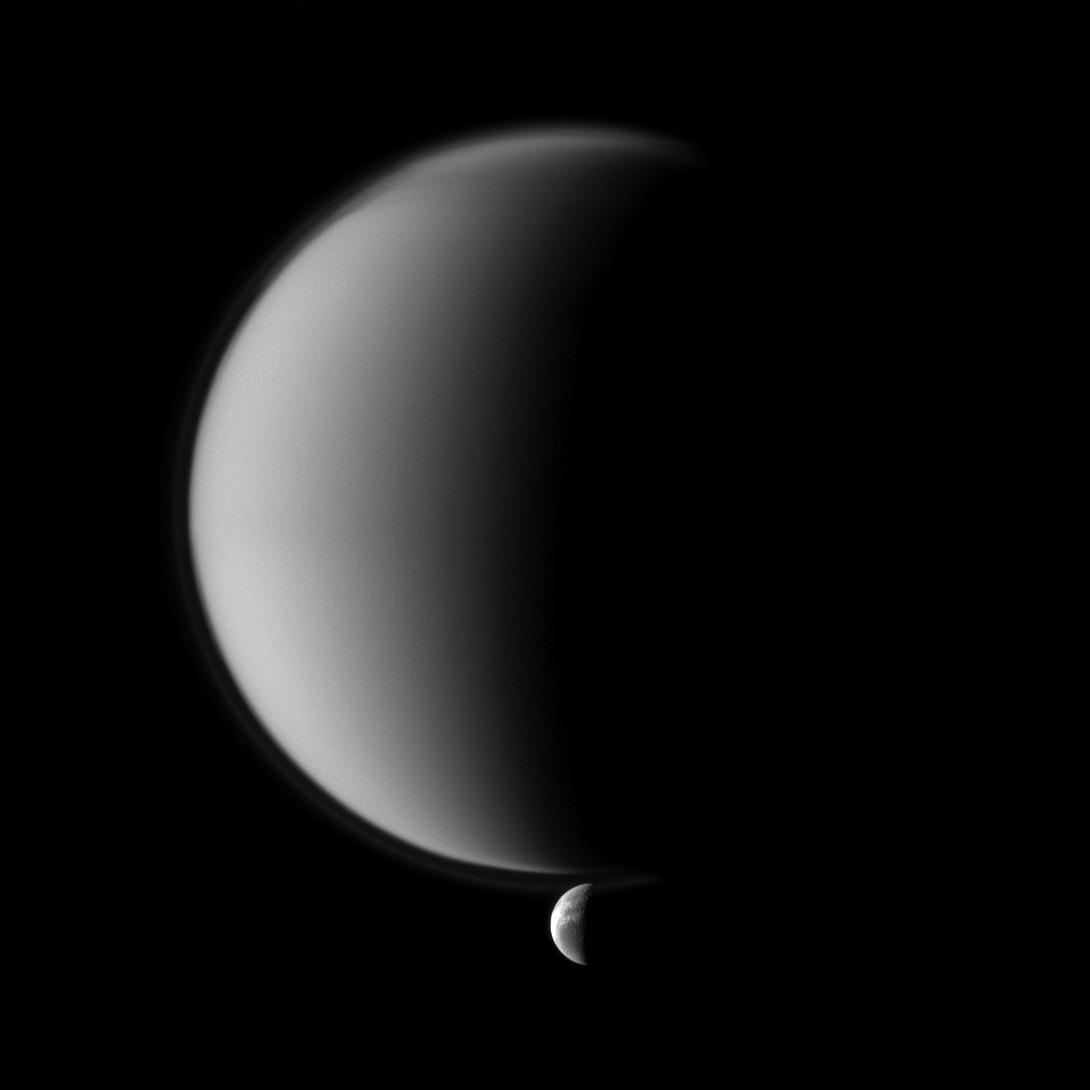 |
This view shows the Opaque Moon Titan and the icy moon
Dione which orbits closer to Saturn. Saturn's largest moon is in
the upper part of the image and the crescent of Dione appears at the
bottom of the view. Titan is covered with a thick and dense atmosphere
while Dione is devoid of any atmosphere. Image Credit: NASA/JPL/Space Science Institute |
This radar view unveils the dark kidney-shaped area of
Ontario Lacus in the southern hemisphere of Saturn's largest moon Titan.
Ontario Lacus appears to be the largest pool of liquids in the south
polar region. The lake is approximately 235 km long and is centered
at 72 degrees south latitude, 183 degrees west longitude. Image Credit: NASA/JPL-Caltech |
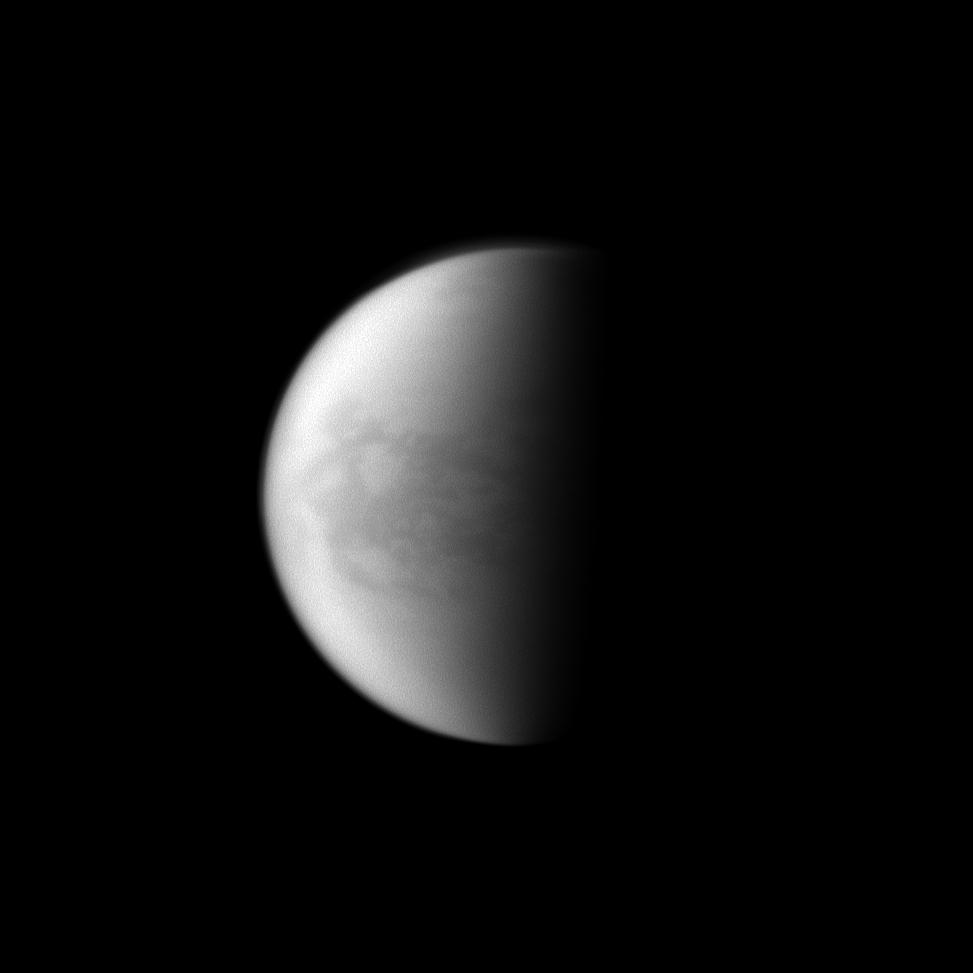 |
The infrared image above reveals a crescent of Titan's
disk. The dark low-latitude region Belet can be observed in the illuminated
area of Saturn's largest moon. It seems that Kraken Mare, the giant
pool of liquids in the north polar region, can be identified in the
upper
part of the disk. The illuminated terrain appears between the trailing
hemisphere and Saturn-facing side of the Orange Moon and north is up. Image Credit: NASA/JPL/Space Science Institute |
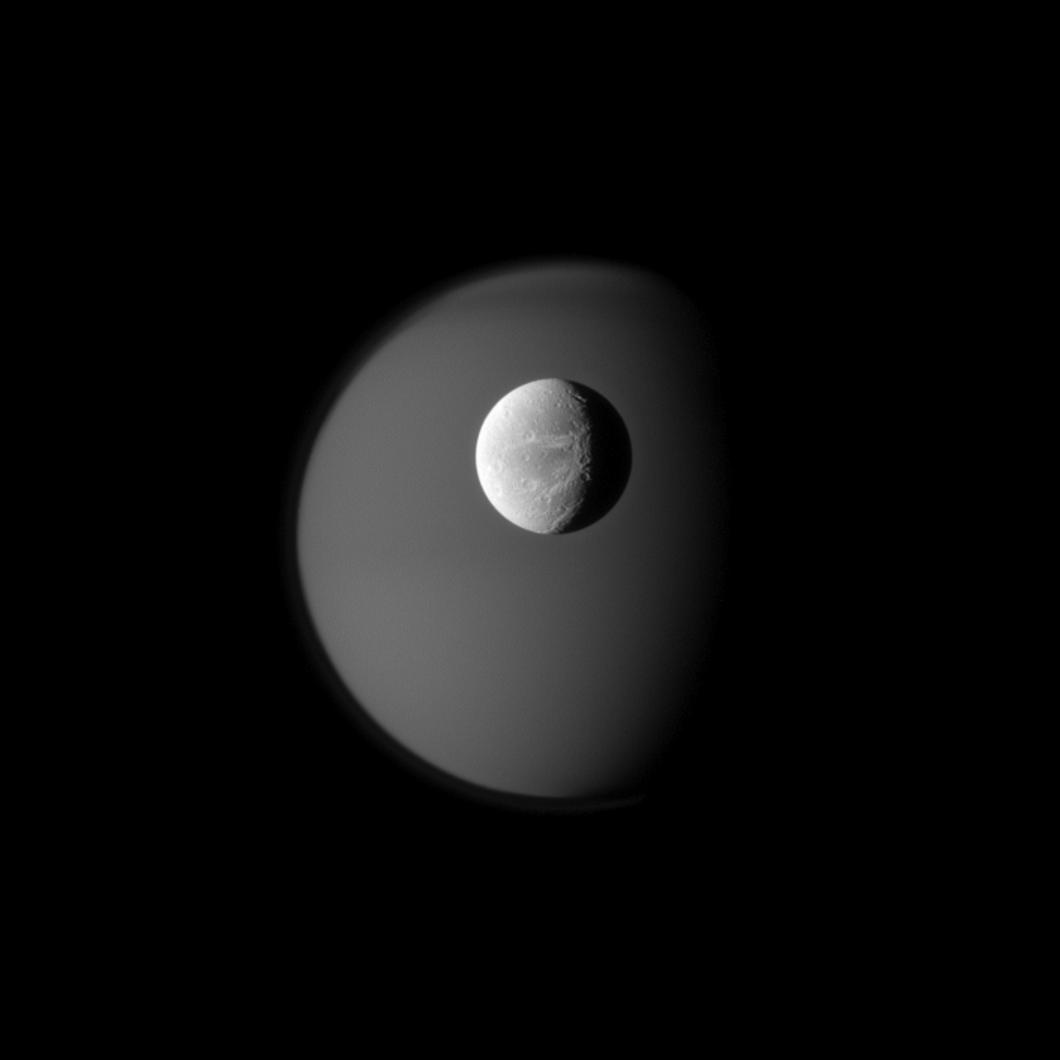 |
| This view acquired from the Cassini spacecraft on April
10, 2010 shows Saturn's moon Dione moving in front of the hazy, ghostly
Titan. Surface features such as bright streaks or craters of the bright
moon Dione can be clearly discerned in the image. A portion of the bright ice cliffs in the trailing hemisphere of Dione can be observed on the right. The ice cliffs of the icy moon are likely generated by tectonic forces. The camera is orientated toward the Saturn-facing hemisphere of Titan and Dione. One can notice that the north polar region of the opaque moon Titan is covered by a dark atmospheric banding, known as the dark polar hood. The dark polar bands are thought to be closely related to seasons. Titan appears to be the largest moon of Saturn with a diameter of about 5,150 km or 3,200 miles. Dione, approximately 1,124 km or 700 miles in diameter, orbits closer to Saturn with a semi-major axis of 377,396 km or 234,410 miles. The semi-major axis of Titan's orbit around Saturn is about 1,221,870 km or 760,000 miles. The view was obtained in visible blue light with the ISS narrow-angle camera of the Cassini spacecraft. The image was taken at a distance of about 1.8 million kilometers or 1.1 million miles from Dione and 2.7 million kilometers or 1.7 million miles from the Orange Moon. The view has been magnified by a factor of 1.5 and contrast-enhanced to improve visibility. Image Credit: NASA/JPL/Space Science Institute |
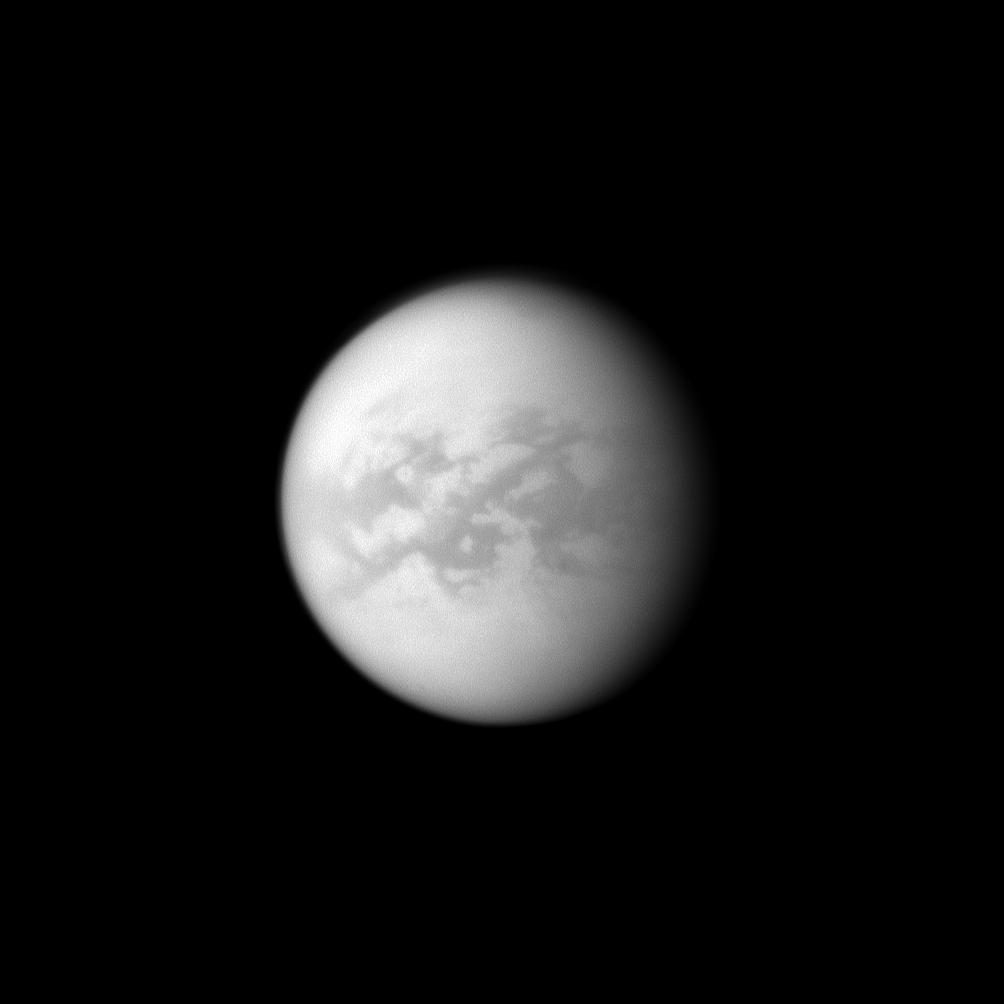 |
This global view of Saturn's largest moon Titan clearly
shows the dark low-latitude regions Fensal, Aztlan and Senkyo. Fensal
and Aztlan separated by the bright Quivira in the left part of the
disk form a topographic "H". The dark Aztlan appears below
the equator and the dark Fensal is located north of Aztlan. The bright
region below
the topographic H is called Tsegihi. Image Credit: NASA/JPL/Space Science Institute |
This near-infrared portion shows the Belet area on
Saturn's largest moon Titan. The bright patches are not clouds or atmospheric
features. They represent topographic or surface features. The bright
patches are high-albedo areas or particularly reflective areas. By
contrast, dark areas
present
a lower albedo which implies that they reflect a smaller portion of
the incoming radiations. Image Credit: NASA/JPL/Space Science Institute |
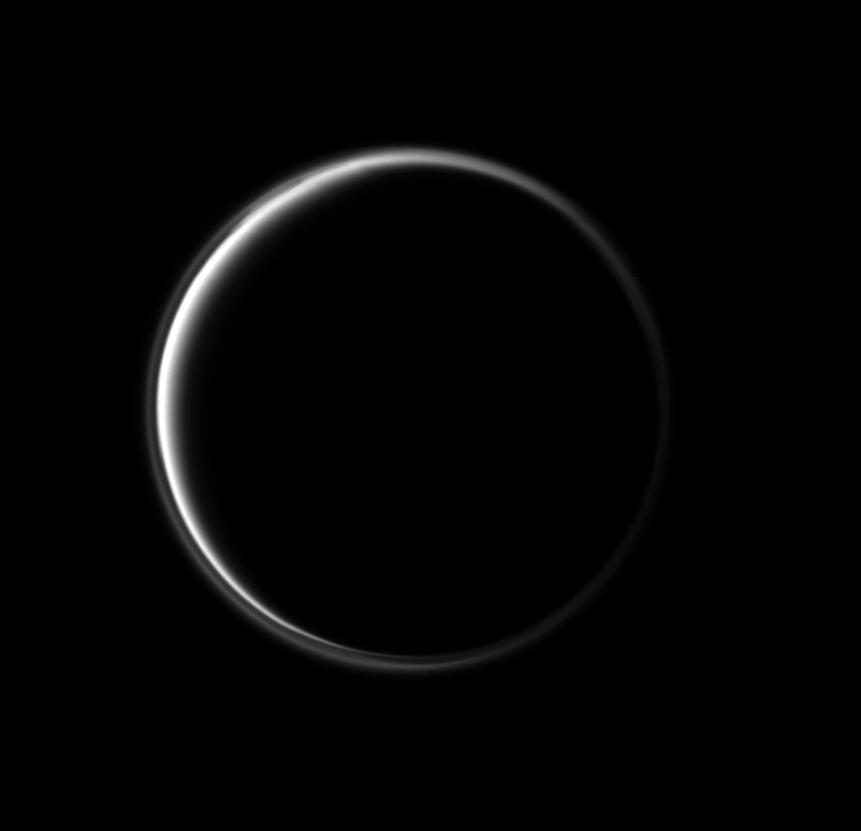 |
This ultraviolet view of Titan's disk clearly shows the
detached, high-altitude haze layer in the upper part of the atmosphere.
A large part of the disk of Saturn's largest moon is not illuminated
by the solar light. As a result, very few atmospheric features can be
discerned in the global image. Image Credit: NASA/JPL/Space Science Institute |
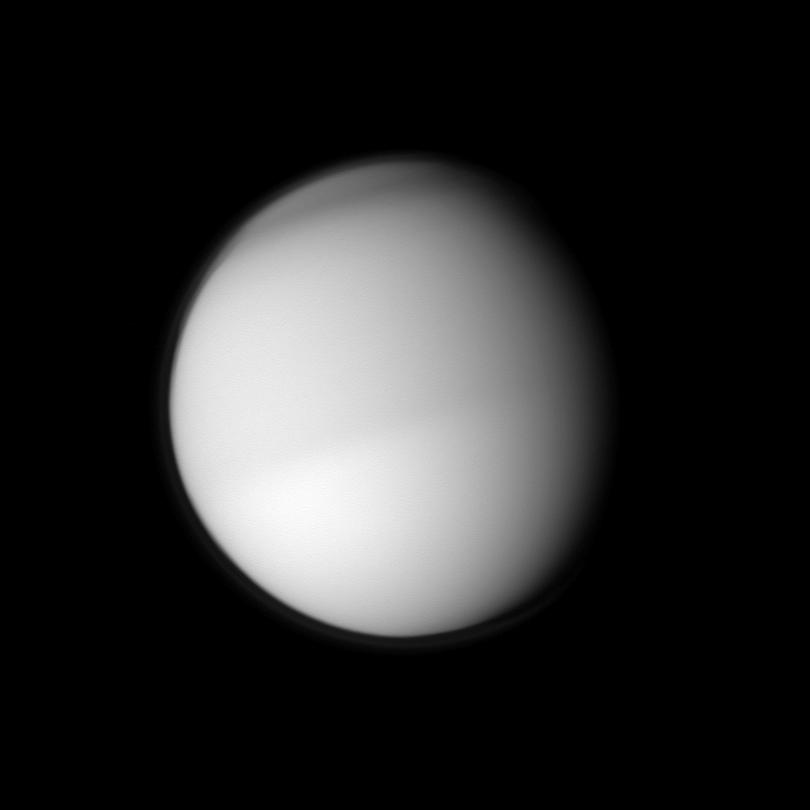 |
This view of Titan's disk reveals the brightness dichotomy
between the southern hemisphere and the northern hemisphere. One can
clearly notice the dark hood in the north polar region of Saturn's largest
moon. Image Credit: NASA/JPL/Space Science Institute |
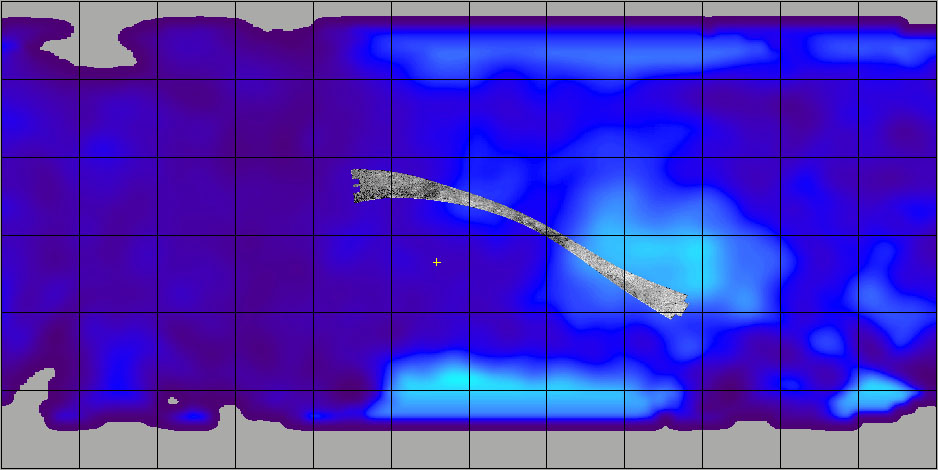 |
This set of images shows a radar portion of Saturn's
largest moon ,Titan. The radar strip was obtained by the radar mapper
of the
Cassini spacecraft on May 28, 2008 and it represents the last swath
acquired during Cassini's prime mission. The top view corresponds to
the radar
swath. The second view represents the radar swath with color boxes
incorporated to show key locations on the moon. The lower view represents
a cylindrical
projection map of the globe with the radar swath incorporated to indicate
where the key places are situated. One can notice that the radar strip
crosses the bright area called Xanadu. Image Credit: NASA/JPL-Caltech |
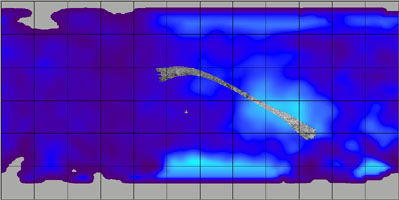 |
This set of images reveals a radar swath of Titan's surface
acquired on May 12, 2008 by the radar mapper of the Cassini probe. The
image in the upper part corresponds to the radar portion. The second
image from top represents the radar swath with annotations or rectangles
to show key topographic locations. Thre lower view represents a map of
the moon incorporating the radar swath. Image Credit: NASA/JPL |
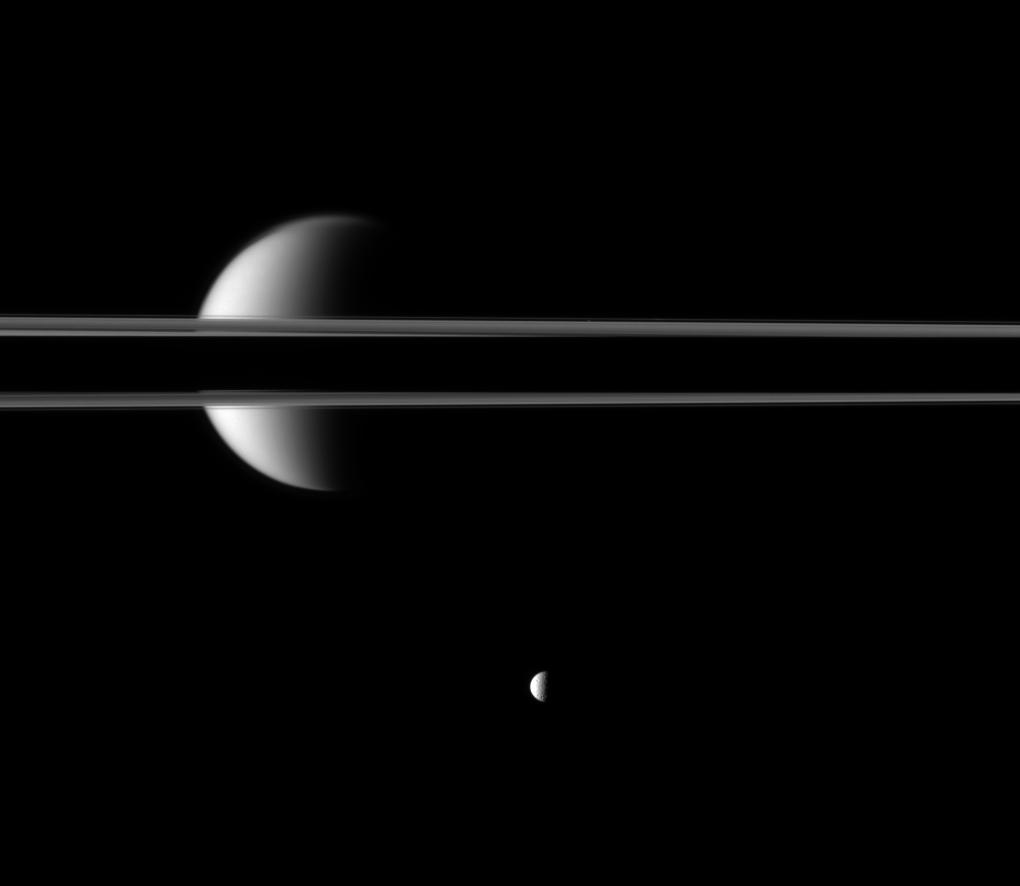 |
This view reveals a surprising geometrical configuration
in the Saturn System with Titan crossing the ring plane of Saturn on
the horizon and the icy moon Mimas in the lower part of the image below
the rings. Image Credit: NASA/JPL/Space Science Institute |
This near-infrared view shows surface features in the
bright region Adiri on Saturn's largest moon Titan. Adiri is located
to the west of the dark region Shangri-La where the Huygens probe landed
on January 14, 2005. The landscape portion is centered on terrain at
22 degrees south latitude, 209 degrees west longitude.
North appears in the upper part of the view and is tilted 36 degrees
to the right. Image Credit: NASA/JPL/Space Science Institute |
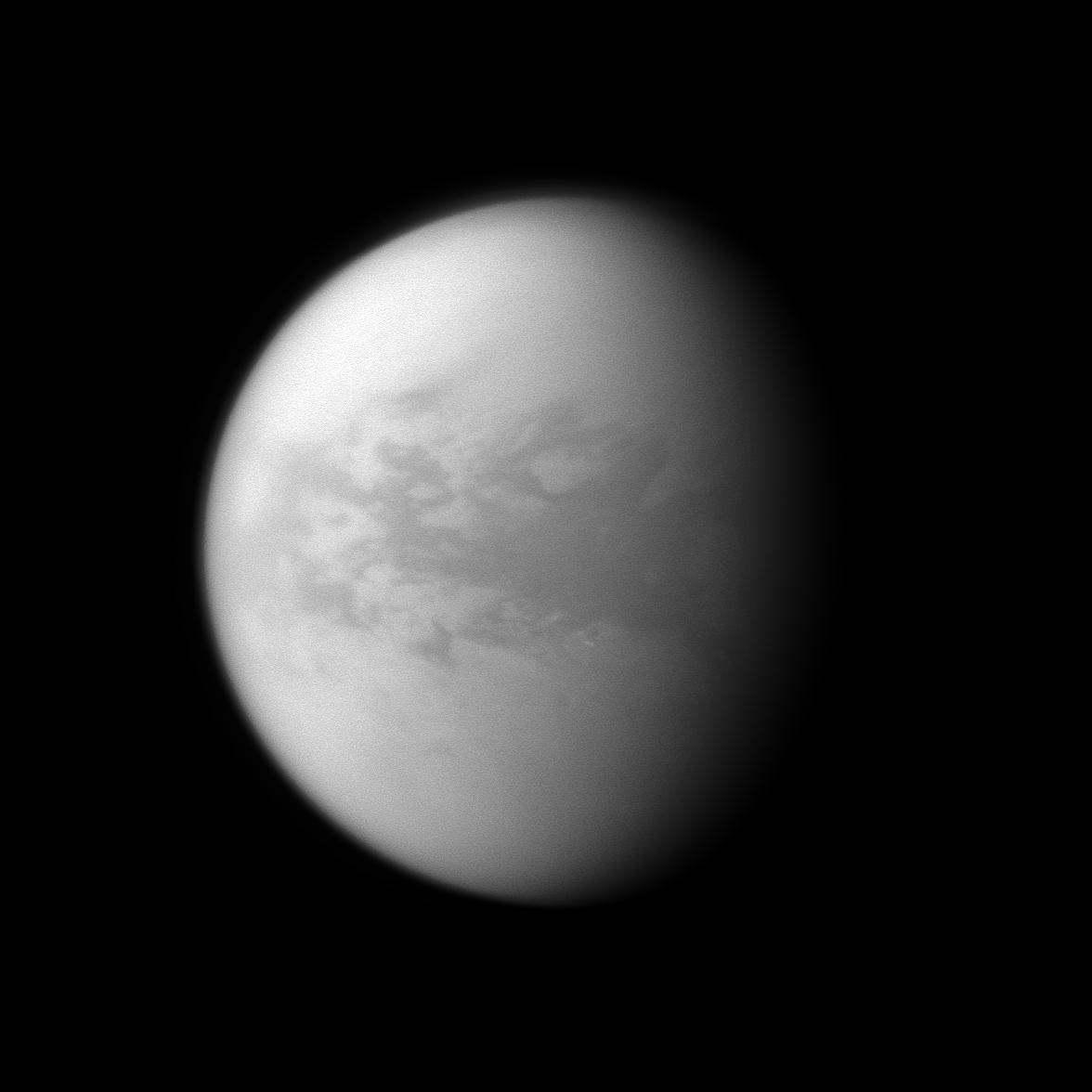 |
This near-infrared view of Titan's disk shows the optically-dark
area of Belet located within the "Tropics" of Saturn's largest moon.
The narrow-angle camera of the Cassini spacecraft is focused
toward the
trailing hemisphere of the Orange Moon. North is in the upper part
of the disk
and is inclined
2 degrees to the right. Image Credit: NASA/JPL/Space Science Institute |
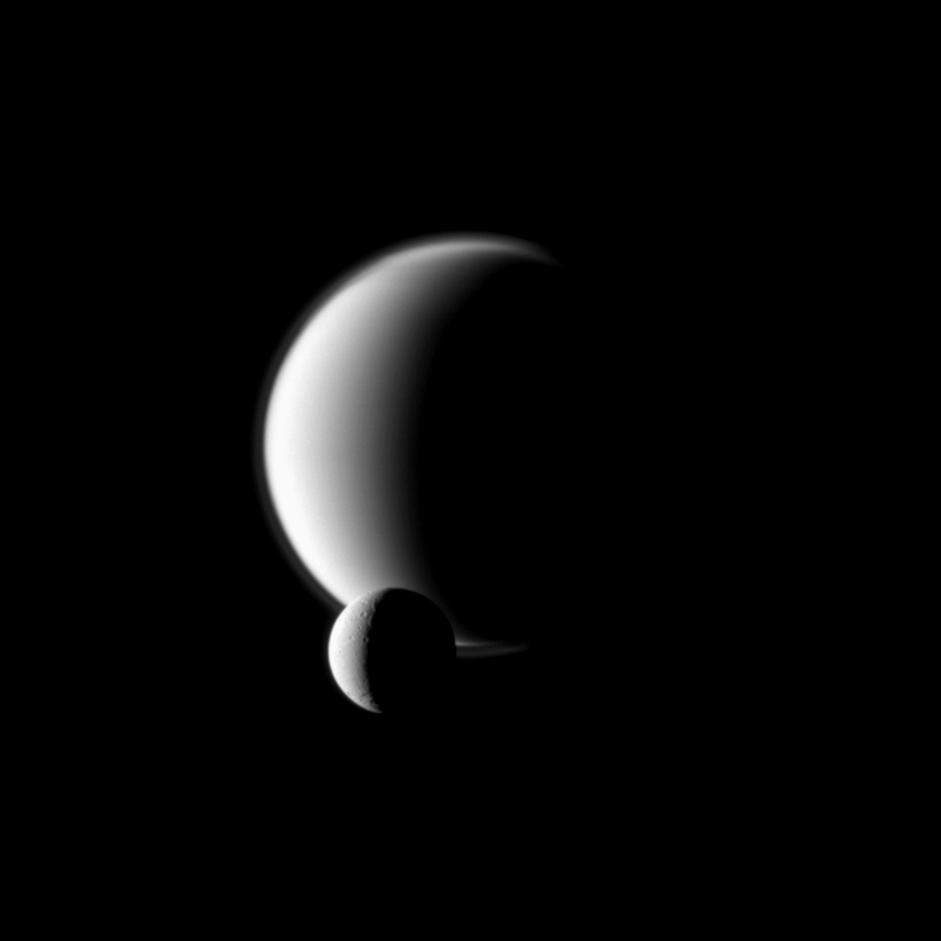 |
This view obtained in visible blue light with the ISS
narrow-angle camera of the Cassini probe on March 12, 2010 shows the
icy moon Dione passing in front of Saturn's largest moon Titan. Image Credit: NASA/JPL/Space
Science Institute |
 |
This near-infrared view of Titan's disk clearly reveals
the upper boundaries of the thick, dense and opaque atmosphere of
Saturn's largest moon. A detached, upper haze layer appears in the
upper part
of the gas blanket encircling the Orange Moon. Image Credit: NASA/JPL/Space Science Institute |
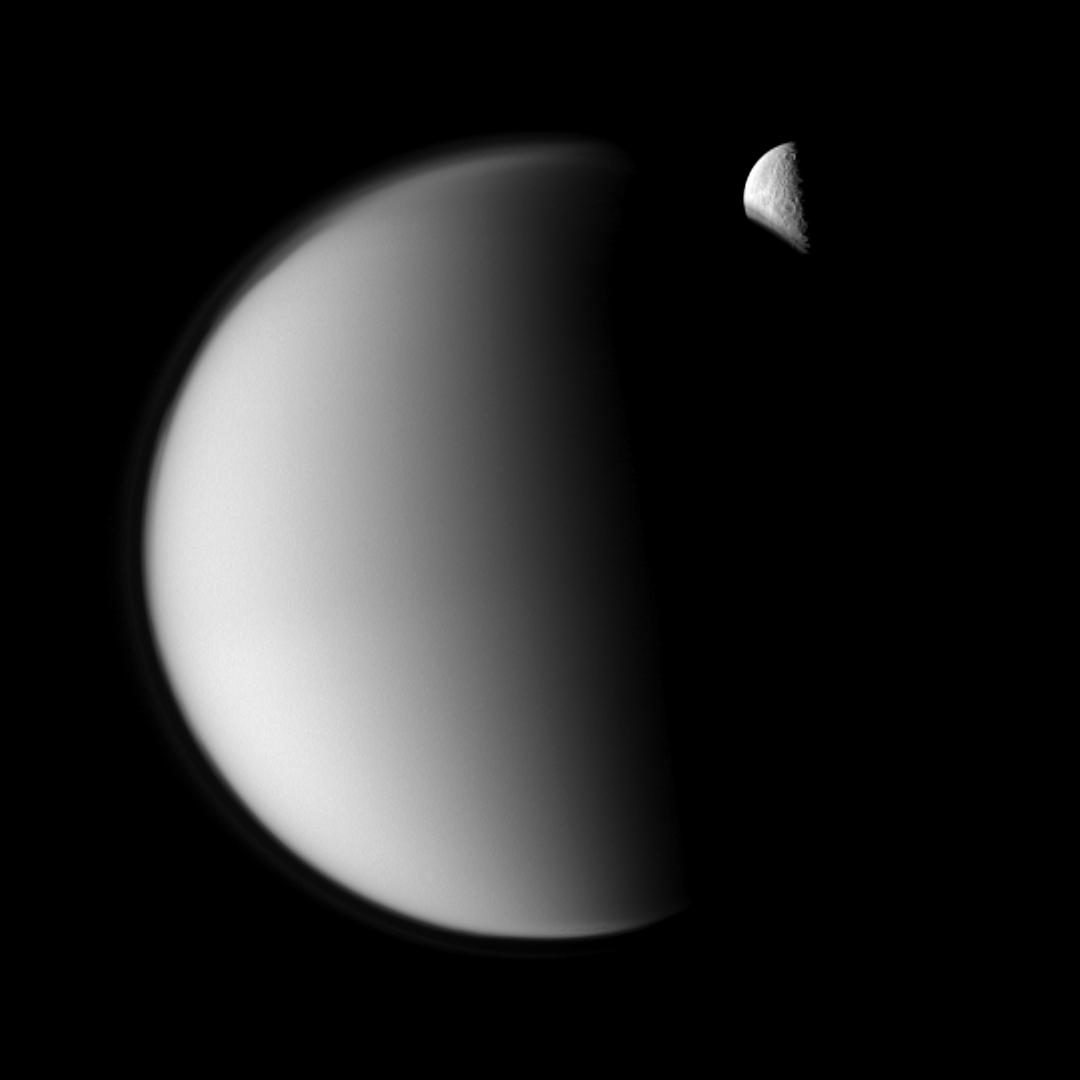 |
This image shows the Orange Moon, Titan, in the foreground
and Rhea in the background, beyond Saturn's largest moon. Rhea orbits
closer to Saturn than Titan at a mean distance of about 527,108 km
or 327,397 miles. Titan evolves farther at a mean distance of 1,221,870
km or 758 926 miles from Saturn. Titan is 5150 km or 3200 miles across
whereas Rhea is only 1528 km or 949 miles across. Image Credit: NASA/JPL/Space Science Institute |
This near-infrared view shows the area of the bright Adiri
on Saturn's largest moon, Titan. The camera scans the anti-Saturn side
of the moon. The view, observed here, is centered on terrain at 2 degrees
south latitude, 218 degrees west longitude. North is in the upper part
of the image and inclined 6 degrees to the left. Image Credit: NASA/JPL/Space Science Institute |
 |
This near-infrared view of Titan's disk reveals the seasonal
brightness dichotomy between the northern hemisphere and the southern
hemisphere. Image Credit: NASA/JPL/Space Science Institute |
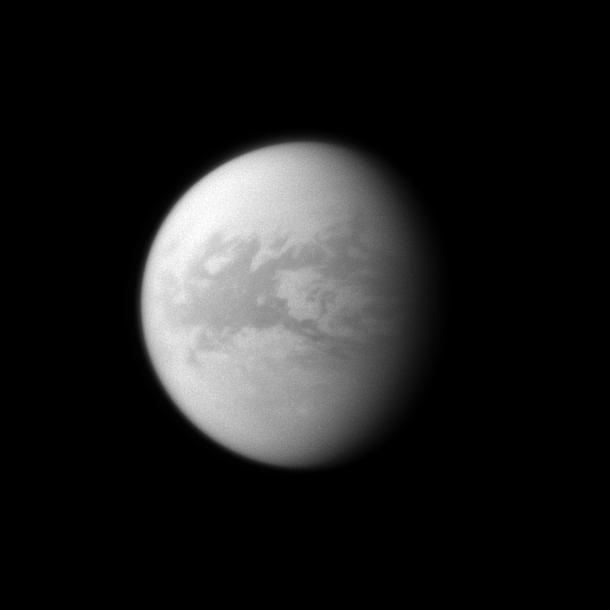 |
This near-infrared view of Titan's disk unveils the
dark region of Belet which can be found at 240 degrees west longitude
in the
equatorial area. The optically-dark Belet has a relatively low albedo
compared to the widespread bright areas such as Adiri or Xanadu.The
amount of light diffusely reflected in the Belet region appears relatively
low. Image Credit: NASA/JPL/Space Science Institute |
This mosaic of images acquired from the Cassini spacecraft
unveils the enigmatic Hotei Regio, an optically bright area on Saturn's
largest moon Titan. Hotei Regio appears to the east of the bright area
of Xanadu
and
Hotei Arcus can be found at 28 degrees south latitude and 79 degrees
west longitude. Image Credit: NASA/JPL/USGS/UA |
This mosaic of different types of images reveals the intriguing
region "Hotei Regio" on Saturn's largest moon, Titan. Hotei Regio corresponds
to the optically bright area where Hotei Arcus is found. Image Credit: NASA/JPL/USGS/UA |
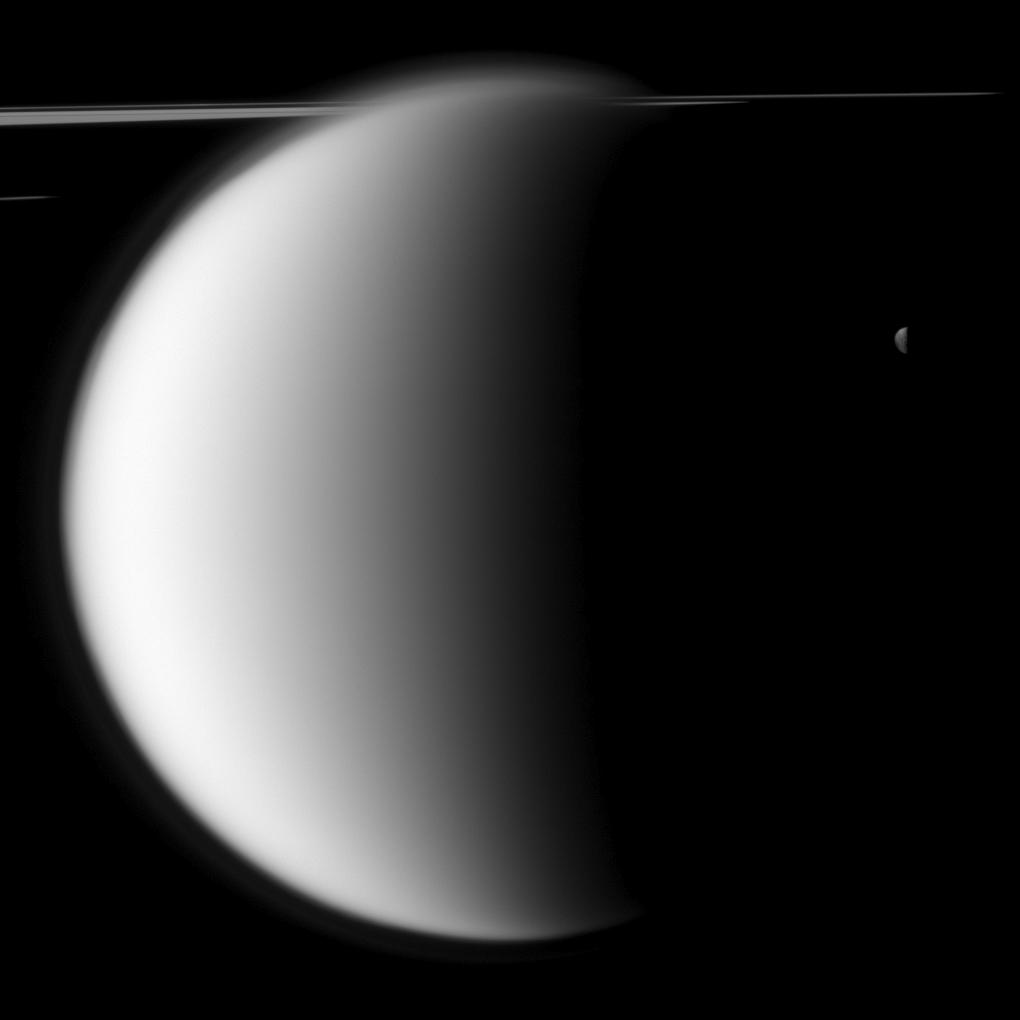 |
This view of the ISS narrow-angle camera of the Cassini
spacecraft shows Saturn's largest moon Titan in the foreground, Mimas
in the background and a portion of Saturn's rings. The image was captured
shortly before the Orange Moon passed in front of and occulted the
icy moon Mimas, as observed from the camera of the probe. That kind
of relative
movement of celestial bodies, in which one object passes close to or
in front of another allows scientists to improve their understanding
of the orbits of Saturn's moons. Image Credit: NASA/JPL/Space Science Institute |
This radar image of Titan's surface reveals, notably,
topographic wrinkles or grooves as well as low mountains at mid-latitudes
of the northern hemisphere. Image Credit: NASA/JPL |
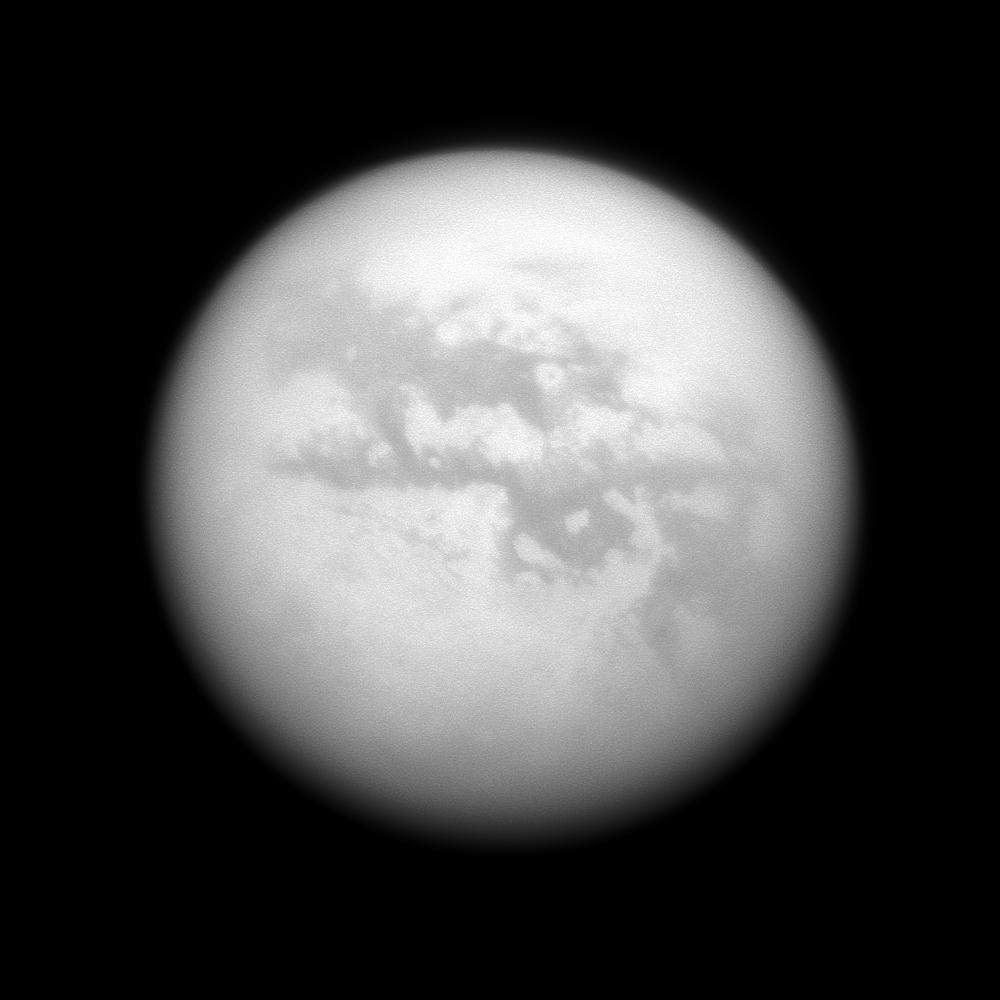 |
This near-infrared view of Titan's disk unveils, in
particular, the "H" of the dark albedo features Fensal and
Aztlan separated by the bright region Quivira which is situated near
the center of
the disk
in the tropical latitudes of Saturn's largest moon. To the East of
Aztlan, one can notice the region of Senkyo, a relatively low-albedo
feature
with a bright western border with two bright upper extensions with
a shape reminiscent of the ears of a cony. At about the same longitude
as Senkyo, above Senkyo and at about the same latitude as Fensal below
30 degrees north latitude, one can spot Aaru. The optically-dark regions,
mostly located in the low latitudes of Titan tend to be dominated by
dune fields similar to Seif dunes on our planet. Image Credit: NASA/JPL/Space Science Institute |
This natural color view reveals Titan and Tethys, with
Titan partly eclipsing Tethys which is moving farther from the Cassini
spacecraft in that particular configuration. Image Source: NASA/JPL/Space Science Institute |
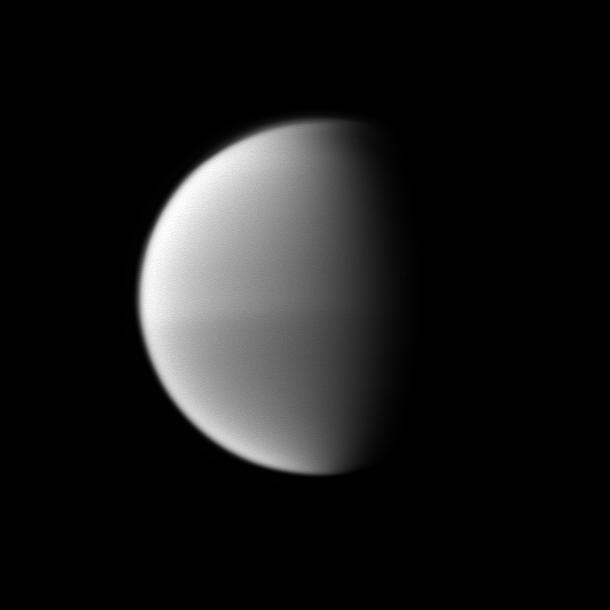 |
This near-infrared view of
Titan's disk reveals the seasonal hemispheric dichotomy of Saturn's
largest moon, the northern half appearing, at this time, slightly brighter
than the southern half. Image Source: NASA/JPL/Space Science Institute |
Titan Images
2009
Titan Images 2008
Titan
Images 2007
Titan
Images 2006
Titan
Images 2005, 2004
